Adventure Course Elements and Sample Itineraries
Developing a well–planned and properly–sequenced program is not only critical to achieving good outcomes; it can also help to reduce the likelihood of accidents. At the Alley Pond Adventure Course, facilitators assess each group based on their needs and goals–derived from the client's own reservation form–to plan a unique program for that group.
Each initiative, low element, and high element, along with the careful guidance of our facilitators, can separate cliques, promote teambuilding, trust building, communication skills, leadership, self–confidence, problem–solving skills and, as always, incorporate your suggested goals.
Low Elements
Broken Bridge
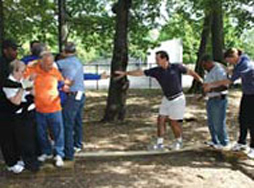
Click on the photo to view a large version
Three or more wooden platforms are placed about six to eight feet apart. The outer platforms are large enough to fit a group of about ten to twelve participants, while the center platforms can hold only about half that amount. The group is given two boards (one long and one short) to aid them across the "Broken Bridge." Their goal is to cross the element without either the boards or themselves ever touching the ground. Broken Bridge works effectively as a tool for communicating, leadership, critical thinking, planning, and cooperating.
Mohawk Walk
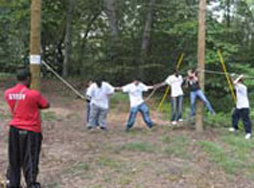
Click on the photo to view a large version
The Mohawk Walk is a traversing element built using foot cables that are strung approximately eighteen inches above the ground. The Walk consists of several segments of cable strung from anchor point to anchor point. Each segment varies in length and difficulty. Our Mohawk Walk incorporates Multivine, swing steps, step–across–sections, and Tension Traverse elements. The team attempts to traverse the entire Walk without making contact with the ground. The Mohawk Walk works effectively as a tool for communicating, leadership, cooperation, planning, and critical thinking.
Nitro Crossing
Nitro Crossing is a swinging element that consists of two foot–loop ropes suspended from an overhead cable and spaced approximately ten feet apart. Under each rope is a platform or "island." The team, once split into two groups, must strategize and execute a plan that–using only the foot–loop ropes–gets every member of their team to the other side of the element, landing only on the platforms and without making contact with the ground. Nitro Crossing works effectively as a tool for communicating, leadership, cooperation, planning, and critical thinking.
Nitro Swing
Nitro Swing consists of a wooden seat suspended by ropes about two feet off of the ground from a steel cable stretched between two telephone poles about twenty feet apart. On the ground at either end are platforms (or "Islands"). The team's first goal is to retrieve the swing which dangles just out of reach of the first platform. Once retrieved, the team must try to get each of its members from one platform to the other using only the swing. Nitro Swing works effectively as a tool for trust building, communicating, cooperating, and problem solving.
Team Triangle
Team Triangle consists of three foot cables approximately fifteen inches above the ground forming a triangle. Each cable is installed with more slack than most other low element foot cables. The distance between the supporting poles is about eighteen feet. Short sections of rope hand–lines or climbing holds are located at each corner of the triangle. A six–foot–square platform is located within the center of the triangle. Team members begin the element standing on the platform. Without making contact with the ground, every member of the team attempts to touch each pole at each corner. Team Triangle works effectively as a tool for communicating, leadership, cooperating, and demonstrating how we are all connected.
TP Shuffle
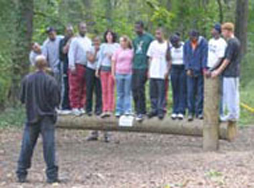
Click on the photo to view a large version
The TP Shuffle is a traversing element that is similar to a balance beam. A telephone pole is placed a few feet off of the ground using shorter supporting poles. All of the team members stand on the pole and attempt, one at a time, to change positions and navigate to the other side of the element without ever stepping off of the pole. The team may utilize many different methods to get each of their team members to traverse the pole. The TP Shuffle works effectively as a tool for exploring trust issues, communicating, planning, and teamwork.
Trolleys
Trolleys are a series of planks with ropes attached for support. Typically, participants stand on the Trolleys with the support ropes firmly in their grasp and work together to maneuver their team from one destination to another. Trolleys encourage different styles of communication and listening skills. Participants are encouraged to work not only on communicating their needs but also listening to the needs and concerns of others. Trolleys work effectively as a tool for communicating, leadership, planning, and team building.
Trust Fall
The Trust Fall is a series of four steps that stop approximately four feet from the ground. Using a serious of commands, participants fall from the top step into the arms of the spotters waiting behind/below the participant. Proper spotting techniques and commands are taught and utilized by the team. Trust Fall challenges individuals to step outside of their normal comfort zone and challenge themselves on new and exciting levels. Trust Fall works effectively as a tool for communicating, trust issues, and developing teamwork.
Whale Watch and Moby Deck
The Whale Watch is a large wooden rectangular–shaped platform which is balanced on a low beam and pivots from side to side at about twelve to eighteen inches from the ground, and is usually four feet wide by ten feet long.
Moby Deck, like Whale Watch, is also a wooden platform, except it is octagonal–shaped and supported by a central pivot. It thus allows for more directions of movement. Both elements challenge the group to use their weight to find balance on the platform. This element allows individuals within the group to discover what role(s) they play within their team. Their slightest movement can have an enormous impact on the group's success. Both Whale Watch and Moby Deck work effectively as tools for communicating, finding balance, and team building.
Wild Woosey
The Wild Woosey is a cable traverse element. The cables are strung in the shape of a V (using four anchor points) about eighteen inches above the ground. Each side of the V is approximately fifteen to twenty feet in length. The cables at the end of the element are approximately ten feet apart. Two team members work together to traverse the element. Each team member stands on a cable facing the other person. The pair begins on the narrow end of the V and attempts to move along the cables as far as possible by leaning into each other. Spotting is provided by the remaining members of the group. The Wild Woosey works effectively as a tool for communicating, cooperation, and trust building.
High Elements
Cat Walk
A horizontally positioned telephone pole suspended about forty feet from the ground between two telephone poles approximately fifteen feet apart to create a heart–pounding and fun traversing element. Participants are placed securely into a harness and climb using a belay line connected to a facilitator below. Participants traverse the pole, walking across while trying to maintain their balance. As with all of our highs, this element allows participants to challenge themselves while accepting help from others. Cat Walk works effectively as a tool for trust building, communicating, and boosting self–confidence.
Centipede
A series of vertically suspended four–by–four poles with randomly placed staples creates a long, dangling element requiring the participant to climb about forty feet into the air. Centipede is a high element that encourages participants to trust themselves to reach new heights both physically and mentally, while maintaining communication with their facilitator. Centipede works effectively as a tool for communicating, boosting self–confidence, and trust.
Climbing Wall
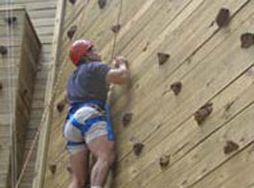
Click on the photo to view a large version
The Climbing Wall is the most recognized element of all of our high elements. A wooden wall towers at approximately thirty to thirty–five feet high. With six climbing lanes of three differing levels of challenge to choose from, participants may select their level of challenge. Rock climbing walls bring out the kids in all participants while providing real–world challenges. The Climbing Wall works effectively as a tool for communicating and self–confidence.
Dangle Quad
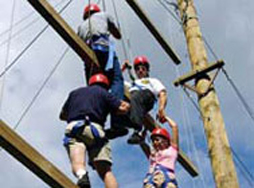
Click on the photo to view a large version
This element resembles a giant ladder. The "rungs" are suspended from steel cables–the distance separating each increasing as the element rises up–with the top "rung" standing approximately forty feet in the air. Usually, two to four participants work together to climb from one board to the next. While only a maximum of four climbers can ascend the element at any time, each climber is belayed to three members of their team, thus requiring a team effort. Dangle Quad works effectively as a tool for cooperating, communicating, and self–confidence.
Human Swingshot
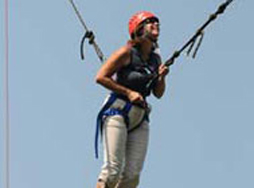
Click on the photo to view a large version
The Human Swingshot consists of a vertical swing cable, suspended from the middle of the support cables, and a rope lanyard, connected to the swing cable. The team member begins the activity suspended from a rope lanyard that is connected to the swing cable. She is pulled from the starting position (near the ground) to the top of the swing arc by a haul line controlled by the other team members. The team member releases herself from the haul system by pulling a small trip cord. Once released, the participant swings down on the swing cable. The amount of swing is determined by the height at which the team member releases herself. The Human Swingshot works effectively as a tool for trust building, self–confidence, communicating, and cooperation.
Leap of Faith (Plank/Pole)
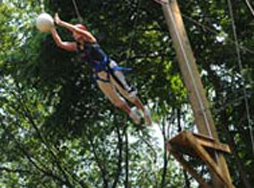
Click on the photo to view a large version
The Leap of Faith is a utility pole/plank (or small platform) about thirty–five feet high. A staple climb provides access to both. Above the Leap of Faith pole and off to one side, a buoy is suspended (about seven feet away). The Leap of Faith Plank is similar except that a larger platform is attached to the side of the pole. The team member climbs up the pole to the top of the pole or plank. She stands on the pole/platform and dives for the target buoy, suspended from the cable, trying to hit the target buoy with her hand. The Leap of Faith works effectively as a tool for trust building, self–confidence, communicating, and cooperation.
Tension Traverse
The Tension Traverse is a belayed version of the popular lower element. There is a forty–foot–long foot cable, an overhead belay (Static or Dynamic) cable, and a horizontal hand–line. A team member climbs to the foot cable and, using the hand–line for support, attempts to traverse to the opposite side. The Tension Traverse works effectively as a tool for self–confidence, communicating, and cooperation.
Zip Line
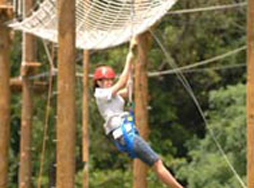
Click on the photo to view a large version
The Zip Line is a popular and exhilarating high element. Two steel cables run from above the Zip Line platform to two telephone poles about a hundred yards away. The platform, standing about forty feet above the ground, can move and shake a bit, which adds to the intensity of the experience. Participants are asked to step outside of their normal comfort zone and take a leap into an experience that can only be described after trying it. The Zip Line works effectively as a tool for trust building, self–confidence, and communication.